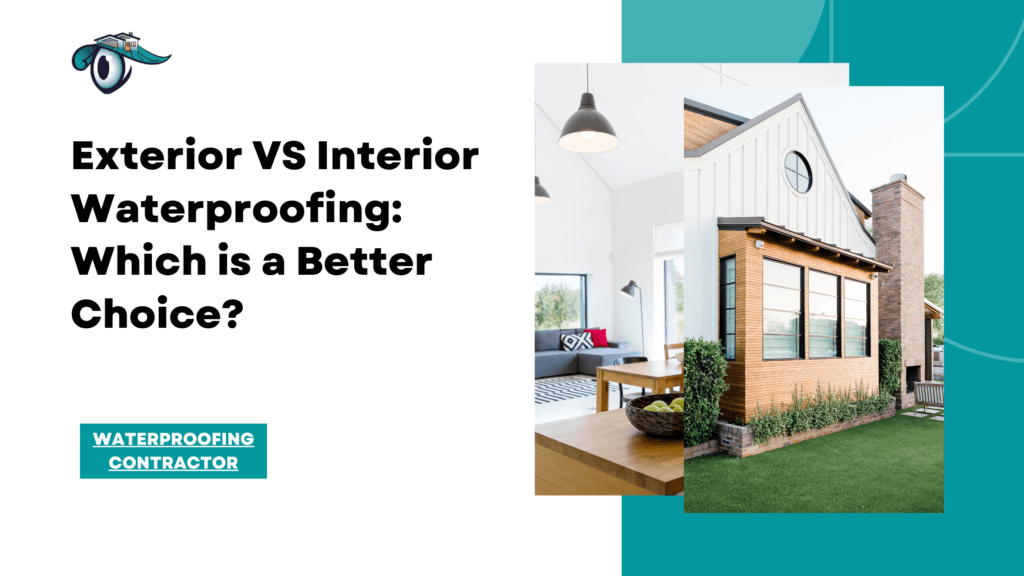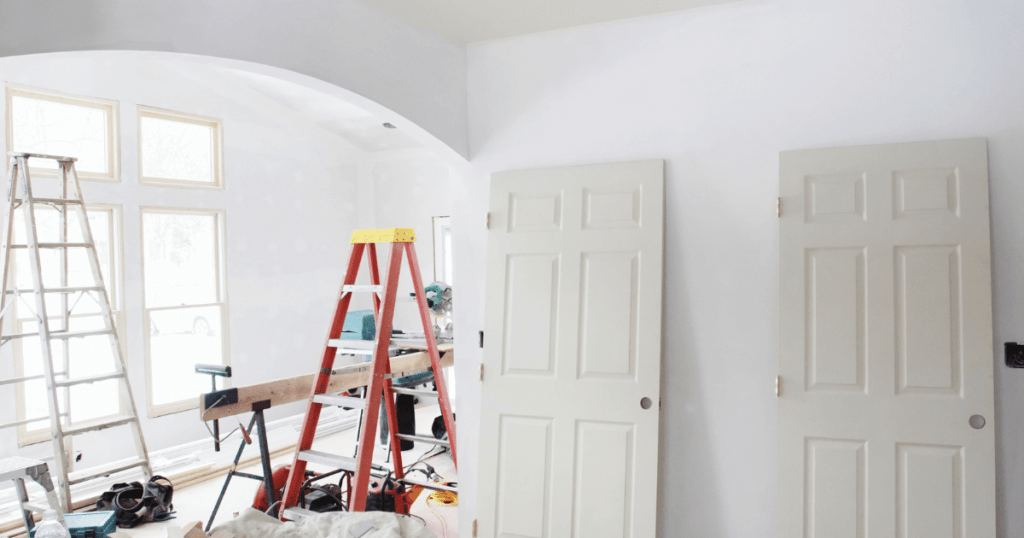The groundwater seeps through the foundation’s walls and into your basement. Basement waterproofing is especially important since water can easily infiltrate through porous concrete walls and cause flooding.
Water seepage in your basement is also more likely if you reside in a location that frequently has severe rains, snowstorms, or major snow melts. When water enters your home through cracks in the foundation, it may do a lot of damage. If you don’t move quickly to begin waterproofing basement walls, the damage might reduce the structural integrity and value of your property.
Basement flooding can be avoided if homeowners adopt urgent precautionary measures. You need to invest in sufficient time and energy to guarantee the house is in excellent shape.
However, deciding whether to waterproof the basement wall from the inside or the outside might be difficult. It’s also important to consider working with a professional firm. To determine which form of basement waterproofing is best for your property, you must first examine the facts.
WHAT IS INTERIOR BASEMENT WATERPROOFING?
To waterproof a basement from the inside, the inside walls must be sealed. This will redirect any water that finds its way into your basement before it can cause any damage. It’s a good option to outside waterproofing that doesn’t look as bad.
The groundwater is quickly extracted by the inner basement waterproofing system before it may damage your floor. Drainage systems and interior sealants are also part of this. Internal drainage systems consist of pipes and drains that are either put beneath the foundation to collect excess groundwater or are designed to capture leaks.
A sump pump is used to direct water that has accumulated elsewhere in your home to a huge basin, or sump pit, from where it may be safely removed.
Basement flooding can be prevented, in part, by waterproofing the basement’s internal walls. These drainage systems are simple to set up and typically less expensive than external waterproofing.
WHAT IS EXTERIOR BASEMENT WATERPROOFING?
One other highly efficient strategy for preventing water damage to your house is to waterproof the exterior of the basement. Most issues that develop from damp basements are caused by the surrounding environment. Therefore, it is important to think about waterproofing basement walls from the outside, since this is the part of the basement that is exposed to the elements.
In order to install an exterior basement waterproofing system, the soil around your home’s foundation must be excavated. Constantly wet soil expands and exerts strain on the foundation, leading to movement and cracking. After that, groundwater seeps through the crevices in your foundation and into your house. However, waterproofing the exterior of a basement may be a time-consuming and complicated process that calls for a wide variety of specialized equipment. To prevent water from seeping into your basement, a polymer-based waterproof sealant is placed to the outer walls after the dirt is excavated from around the foundation.
Exterior Waterproofing vs. Interior Waterproofing: Key Distinctions
In our article “How Does Interior Waterproofing Work?” we discussed this topic briefly. Waterproofing the interior of a building is not the same as doing so on the exterior. Some examples are:
Location of Setup
Exterior waterproofing, as the name implies, is mostly installed from outside the basement, which is the primary distinction. Because of this, excavation work must be done on the outside of the basement. Basement waterproofing, on the other hand, is often installed from within the space.
How Important a Sump Pump Is
The use of a sump pump system is nearly universally required for interior waterproofing, which is a key distinction. This keeps the weeping tile system from becoming overwhelmed by water. Only if the weeping tile system drains into a storm sewer would a sump pump be superfluous.
The external waterproofing demands of a property (such as a high water table) will determine whether or not a sump pump is required. Since the weeping tile network used in external waterproofing is also located outside, it is possible to install the sump pump there as well. While external waterproofing alone can prevent water seepage, a sump pump is recommended to prevent standing water near the foundation.
Lack of Condensation
The third and last distinction is that external waterproofing is meant to fully exclude water. As a result, once outside waterproofing is in place, the basement wall will be safe from flooding.
Water can still leak through the wall, even if the inside has been waterproofed. However, the basement will remain dry thanks to the internal waterproofing’s smart use of the waterproof membrane and weeping tiles.
We’ve established the background information you’ll need as we discuss the criteria you should use to decide between exterior and interior waterproofing.
Factors to Consider When Choosing Between Exterior vs Interior Waterproofing
Excavation Area Around Your Basement
Excavation area around your home’s foundation is a must for external waterproofing, therefore this is a primary consideration. Therefore, indoor waterproofing is the obvious best option for houses that lack adequate or any excavation area.
Full Moisture Protection
Both systems may be installed to ensure that the basement floor remains dry and free of leaks and puddles. This is accomplished in a variety of ways, depending on whether the waterproofing is on the inside or outside.
To prevent water from penetrating the foundation from the outside, a waterproof membrane is installed on the exterior of the structure. To control the amount of water in the ground, this is coupled with a weeping tile system of the same color.
The interior is made watertight by installing a trench and weeping tile network at the foot of the leaking basement walls. The water that seeps through the basement walls is collected by the system and then pumped out by a sump pump.
In addition to these measures, a vapour barrier consisting of a waterproof membrane is attached to the inside of the leaking walls. This experiment demonstrates how water may still find its way into a basement despite inside waterproofing. But the barrier covers everything and is controlled efficiently.
The Intended Use of Your Basement
In connection with the previously mentioned element, the utilization of the basement may cause some homeowners to favor outside waterproofing above internal waterproofing. Exterior waterproofing is the best option for basements that will be used as permanent living spaces, such as bedrooms, home offices, or rental units. Waterproofing from the outside helps to maintain the inside “drier” without the need for a constantly operating sump pump.
The Project’s Invasive Nature
Because most of the work is done outside the basement, the outside waterproofing system is often regarded as a more minimally intrusive option. Contrast this with internal waterproofing, which necessitates digging tiny trenches.
Therefore, it may be necessary to empty the basement before installing inside basement waterproofing. Exterior waterproofing is the way to go if little intrusion is a priority.
The Waterproofing’s Durability
Exterior waterproofing is more durable and requires less upkeep over time than inside waterproofing. This is because a sump pump is nearly always used as part of an interior waterproofing system. Some interior waterproofing systems, however, can be connected directly to the storm sewer, eliminating the need for a sump pump.
Furthermore, for both of these waterproofing systems, it is essential to remember that the longevity of the waterproofing is affected by the quality of the materials and the completeness of the installation.
Your Budget
Waterproofing an indoor space is typically less expensive than waterproofing an outside one. The initial investment is ignored here. Exterior waterproofing may be worth the additional cost because it requires little to no upkeep.
The Best Ways to Prevent Water Damage to Your Home’s Foundation
Do you want to prevent water damage in your finished basement but can’t because you can’t get to the foundations without tearing down walls? Your home’s outside foundation walls must be sealed to prevent water damage. Your basement’s concrete footings will be well-protected against water and humidity thanks to this.
Our excavation experts discuss exterior home foundation waterproofing.
Dig a trench around the outside of the foundations.
Waterproofing external foundations requires first excavating the soil completely around the perimeter of the building. The only way to get to the complete foundation is to drill all the way down to the bottom of the concrete footing.
Concrete walkways, decking, and landscaping may need to be removed in some instances. Consequently, a permission for occupation must be obtained in advance. Hiring a residential excavating service can help reduce the risk of damage to your home and landscaping. Mini excavators allow these businesses to dig with pinpoint accuracy.
Dealing with a business that provides a multiplex building excavation service is the quickest and most convenient option if the property you want to waterproof is a condominium or a building with numerous apartments.
Repair all concrete cracks and holes.
Once the foundations are revealed, you will have a clearer idea of their condition. Many water and moisture issues in basements may be traced back to structural flaws like cracks and honeycombing, which can be inspected for. Fixing any problems you find can restore the watertight integrity of your foundation walls.
Epoxy resin or polyurethane injection is an effective method for sealing gaps in concrete, preventing water from seeping in from the outside.
Secure a Waterproof Membrane to the Exterior of the Foundation
Foundational concrete is often a porous substance. This implies that if the soil it comes in touch with is saturated with water, water and moisture can still penetrate it even though there are no fractures. Waterproofing the foundation entails affixing a membrane to the exterior of the structure.
Waterproofing a building’s foundation can be accomplished using a variety of membranes. There are two main types of membranes used today: those made of natural rubber (elastomer) and those called “honeycomb” membranes. The latter helps with drainage by lowering the water pressure against the foundation.
It is recommended that a membrane be used to cover the footing for best effectiveness. The membrane must rise above the surface of the earth as well.
Refill The Trench You Dug Around The Piles.
The trench created around the structure may be filled up once the waterproofing membrane has been properly fastened in place.
Make sure your foundation drain is in good working order before you start filling in that large hole. Clean gravel and a geotextile laid on top of it might direct water away from your newly waterproofed foundation and towards the drainage system.
Waterproofing the Basement Exterior
Despite how lovely the landscape may be, you should never let your guard down when it comes to the dirt around your basement’s perimeter. Damp, chilly flooring, and water puddles are symptoms of moisture problems coming from the outside. In addition to keeping the basement dry, exterior waterproofing helps stop mold and mildew growth and discoloration. Exterior drainage, in conjunction with other measures to waterproof the inside, can help you avoid flooding.
Exterior waterproofing begins with diverting water away from the basement and foundation. Gutter and downspout installation is required for this reason. The process of installation is straightforward and won’t damage your garden or landscaping too much. Make sure it is not clogged if you already have one installed.
The next step is to dig a trench around your house’s foundation, lay down a waterproof membrane, and then finish it off with drainage panels. As a result, water won’t be able to seep into your basement and will have a clear path to the drain below your foundation. Make sure it slopes so water doesn’t pool on the edges. If adjusting the slope or grading of the soil surrounding the house helps, do so.
Build drains in your driveway to divert water from the house and into an appropriate drainage area. Make sure yours have metal grates to prevent clogging from leaves and other debris.



